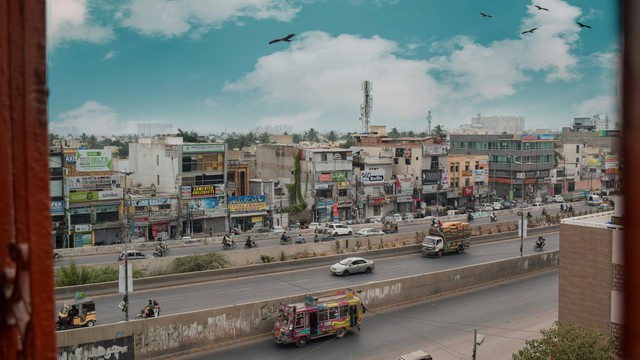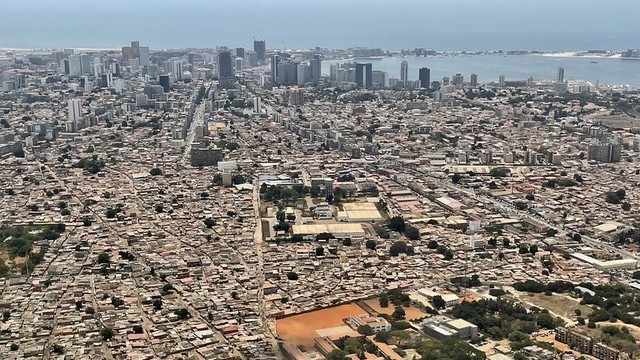The rise of the motorbike
Guest blogger Arif Hasan charts the rise of the motorbike to meet the mobility needs of Karachi’s population.


Motorbike parking in Karachi. Motorbike parking can force vulnerable road users to take their chance with the traffic (Photo: copyright Engineer Mansoor Raza)
Until 1997, Karachi’s public transport had an important government component in the form of the Karachi Transport Corporation (KTC). It had large comfortable buses, depots, workshops and bus stops in the right locations, and people were happy with it.
However, in the mid-1990s it started to run at a loss as its government subsidy was cut. And in the riots of 1994-96, over half its fleet was destroyed. The World Bank pressurised the government to sell the KTC but there were no buyers and the corporation closed down.
Following KTC’s demise people relied entirely on the – mostly individually-owned – 35-seater minibuses. And by 2014 their number had increased to about 30,000. Apart from the discomfort of travelling in these and the rudeness of the drivers, the Karachiites were happy with them.
But government-regulated fares were so low that over time business was no longer as profitable as before. Fares in other cities were much higher, but the government considered Karachi to be volatile and that raising fares could lead to public unrest.
Meanwhile the bus operators complained that they could not get insurance or state assistance to help them modernise or increase their fleets. As a result many minibuses were converted into trucks or sold to operators in other towns.
By 2018, there were less than 7,500 minibuses operating in Karachi while the commuting public had increased from 2.4 million in 2004, to over three million. Karachiites faced a terrible situation, especially working women, who had to seek jobs not of their choice but those dictated by the availability of transport. Cost and travel times also increased.
The final straw
But there is another reason. In 2005, the Supreme Court ruled that all vehicles running on diesel must be converted to compressed natural gas (CNG) for environmental reasons and to cut costs. So Karachi’s minibus owners converted most of their vehicles to CNG. This improved urban air quality, and the operators initially made savings.
However, a crisis occurred in 2008-10 when the price of oil rose substantially and power outages increased in Pakistan. As a result, many businesses installed gas-powered electricity generators. CNG proved to be much cheaper than petroleum or diesel so thousands of private vehicles also converted.
This created a serious shortage with CNG only available to transport operators for two or three days a week. As a result most operators opted out of the public transport sector.
The Qingqi – a possible solution?
The market responded to this crisis by expanding the use and coverage of the Qingqi – a three-wheeler comprising motorcycle with carriage attached, which could carry six people. These were introduced in 2002 initially on routes on the city’s periphery.
However, during the oil crisis their number increased to over 50,000, most of which were registered with the Karachi Qingqi Welfare Association. The association allocated routes, determined fares, identified locations for their stands and negotiated the informal payments that had to be made to the police and to political parties in whose areas their stands were located.
The people of Karachi liked the qingqis because they provided safe and cheap transport. Women were especially appreciative as it meant they could avoid long commutes in very congested, rundown minibuses.
However the minibus operators opposed the qingquis because they were taking away what little business was left to them. Meanwhile, the police said they were causing congestion and lawlessness on the roads. Together, they launched a campaign against them, saying they were not registered as transport carriers but as motorcycles, and that many of their drivers did not have licences and were often underage.
In 2015 the Supreme Court banned qingqis, declaring them to be unsafe and their design to be in violation of government standards. Owners relocated their operations to the outskirts of Karachi, rural areas and other cities.
A motorbike revolution that brings its own problems
During the post-2010 period ride-hailing taxi services made their appearance and became popular with the middle class and the elite. But low-income groups couldn’t afford them.
So the road was clear for the rise of motorbikes and the market responded. They cost around 75,000 rupees (Rs) – a deposit of around Rs30,000 and negotiable monthly instalments of about Rs10,000. The number of motorbikes increased from 500,000 in 2004 to over three million today.
David Satterthwaite writes: Why did we invite Arif to write about these issues? Because it’s an interesting story of how shifting contexts and government policies changed the transport system for Karachi – and usually not for the better. And because these changes helped reshape the city.
One of the difficulties facing urban researchers is combining an understanding of the very local (where we learn about complexity, diversity and engage with local people) and ‘big picture’ stuff on cities and nations.
We learn far more from the local but also that comparisons between localities have limited validity. Each ‘local’ exists within its own unique environmental, economic, social and political context. And this blog illustrates this.
A survey showed that 80% of men at bus stops wanted to buy a motorbike but couldn’t afford one, and 53% of women wanted permission from their families to ride motorbikes. Traditionally, women did not drive motorbikes in Pakistan but as a result of the transport crisis the number of women now doing so is increasing.
Surveys of motorbike owners suggest that aside from the capital cost, commuting by bike is cheaper (about Rs780 per month against average Rs1,570 for buses) and faster (takes half the time) than public transport.
Motorbike taxis?
They are also flexible and, with an enlarged seat, a family of four can travel to places of entertainment and recreation, educational institutions, and to visit family. Motorbike users also mention that they have to deal with high levels of air and noise pollution, and with poor traffic management.
The motorbike revolution has resulted in an increase in traffic accidents. In the past five years there were 720 fatal accidents in Karachi, of which 65% involved motorbikes.
The other major problem is parking. In central Karachi pavements are used to park thousands of motorcycles so pedestrians are forced to walk on busy roads – putting themselves at risk from the often-chaotic traffic.
Karachi has an ambitious programme to construct six bus rapid transits and a circular railway – but this will take at least 10-12 years to complete. During this period motorbike numbers will keep increasing unless their sale is heavily taxed making them unaffordable to the poor – but this will be a terrible discrimination.
The other option is to integrate the needs of motorbike owners and passengers into the city’s planning process to create travel lanes and provision for motorbike parking. This should happen alongside media campaigns to promote road safety. We have not even started thinking about this, but urgently need to do so.
For more of Arif Hasan’s work and articles, see his Wikipedia page and his website.



